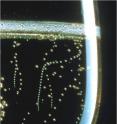The indiscretions of a champagne bubble paparazzi
The innermost secrets of champagne bubbles are about to be unveiled in the Springer journal EPJ ST. This fascinating work is the brainchild of Gérard Liger-Belair, a scientist tackling champagne bubbles from both a physics and a chemistry perspective. Based at the University of Reims, in the heart of the region that gave champagne its name, the author is appropriately affiliated with the 'effervescence team of the molecular and atmospheric spectrometry group' and the 'oenology and applied chemistry' laboratory. To understand what appears to be a harmless phenomenon such as the fizz in champagne, the author studied the role of the carbon dioxide (CO2) throughout its journey from the bottle to the glass. Precisely, Liger-Belair focused on the second fermentation stage, resulting in the CO2 dissolution into the wine -- aided by the addition of yeast and sugar before sealing each champagne bottle -- to the stage where the gas escapes through tiny bubbles popping on the surface of the wine in the glass.
Armed with a high-speed camera, the author produced a series of visually appealing close-up snapshots of the hidden life of these bubbles at every stage of their short existence to analyse the forces at play. He first explained the process underlying their birth through a process called nucleation, triggered by the tiny impurities inside the champagne glass.
He then followed their rise and attributed their extinction when they burst on the surface of the liquid in the glass to the cohesive forces between molecules of the liquid called surface tension. Understanding the source of fizz provides clues on how to fine tune champagne production.
For example, the bubble size can be reduced by a factor that can be calculated by taking into account fermentation sugar levels. However, the method remains fundamentally the same as the one developed by the 17th century Benedictine monk Dom Pierre Pérignon.
Source: Springer
Other sources
- The indiscretions of a champagne bubble paparazzifrom Science DailyTue, 14 Feb 2012, 17:31:56 UTC
- The indiscretions of a champagne bubble paparazzifrom PhysorgTue, 14 Feb 2012, 9:31:01 UTC
